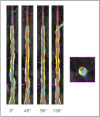Computed Tomography Angiography in the Catheterization Laboratory: A Guide Towards Optimizing Coronary Interventions
- PMID: 39852306
- PMCID: PMC11766008
- DOI: 10.3390/jcdd12010028
Computed Tomography Angiography in the Catheterization Laboratory: A Guide Towards Optimizing Coronary Interventions
Abstract
Cardiac computed tomography (CT) has become an essential tool in the pre-procedural planning and optimization of coronary interventions. Its non-invasive nature allows for the detailed visualization of coronary anatomy, including plaque burden, vessel morphology, and the presence of stenosis, aiding in precise decision making for revascularization strategies. Clinicians can assess not only the extent of coronary artery disease but also the functional significance of lesions using techniques like fractional flow reserve (FFR-CT). By providing comprehensive insights into coronary structure and hemodynamics, cardiac CT helps guide personalized treatment plans, ensuring the more accurate selection of patients for percutaneous coronary interventions or coronary artery bypass grafting and potentially improving patient outcomes.
Keywords: atherosclerosis; computed tomography; coronary angiography; coronary plaque; percutaneous coronary intervention; pre-procedural planning.
Conflict of interest statement
The authors declare no conflicts of interest.
Figures




Similar articles
-
Impact of Fractional Flow Reserve Derived From Coronary Computed Tomography Angiography on Heart Team Treatment Decision-Making in Patients With Multivessel Coronary Artery Disease: Insights From the SYNTAX III REVOLUTION Trial.Circ Cardiovasc Interv. 2019 Dec;12(12):e007607. doi: 10.1161/CIRCINTERVENTIONS.118.007607. Epub 2019 Dec 13. Circ Cardiovasc Interv. 2019. PMID: 31833413 Clinical Trial.
-
Lesion-Specific and Vessel-Related Determinants of Fractional Flow Reserve Beyond Coronary Artery Stenosis.JACC Cardiovasc Imaging. 2018 Apr;11(4):521-530. doi: 10.1016/j.jcmg.2017.11.020. Epub 2018 Jan 5. JACC Cardiovasc Imaging. 2018. PMID: 29311033
-
Fractional flow reserve-guided coronary artery bypass grafting: can intraoperative physiologic imaging guide decision making?J Thorac Cardiovasc Surg. 2013 Oct;146(4):824-835.e1. doi: 10.1016/j.jtcvs.2013.06.026. Epub 2013 Aug 1. J Thorac Cardiovasc Surg. 2013. PMID: 23915918
-
Is it the Time to Move Towards Coronary Computed Tomography Angiography-Derived Fractional Flow Reserve Guided Percutaneous Coronary Intervention? The Pros and Cons.Curr Cardiol Rev. 2023;19(4):e190123212887. doi: 10.2174/1573403X19666230119115228. Curr Cardiol Rev. 2023. PMID: 36658709 Free PMC article. Review.
-
Can Computed Fractional Flow Reserve Coronary CT Angiography (FFRCT) Offer an Accurate Noninvasive Comparison to Invasive Coronary Angiography (ICA)? "The Noninvasive CATH." A Comprehensive Review.Curr Probl Cardiol. 2021 Mar;46(3):100642. doi: 10.1016/j.cpcardiol.2020.100642. Epub 2020 Jun 3. Curr Probl Cardiol. 2021. PMID: 32624193 Review.
References
-
- Linde J.J., Kelbæk H., Hansen T.F., Sigvardsen P.E., Torp-Pedersen C., Bech J., Heitmann M., Nielsen O.W., Høfsten D., Kühl J.T., et al. Coronary CT angiography in patients with non-ST-segment elevation acute coronary syndrome. J. Am. Coll. Cardiol. 2020;75:453–463. doi: 10.1016/j.jacc.2019.12.012. - DOI - PubMed
-
- Vrints C., Andreotti F., Koskinas K.C., Rossello X., Adamo M., Ainslie J., Banning A.P., Budaj A., Buechel R.R., Chiariello G.A., et al. 2024 ESC Guidelines for the management of chronic coronary syndromes: Developed by the task force for the management of chronic coronary syndromes of the European Society of Cardiology (ESC) Endorsed by the European Association for Cardio-Thoracic Surgery (EACTS) Eur. Heart J. 2024;45:3415–3537. doi: 10.1093/eurheartj/ehae177. - DOI - PubMed
-
- Kočka V., Thériault-Lauzier P., Xiong T.Y., Ben-Shoshan J., Petr R., Laboš M., Buithieu J., Mousavi N., Pilgrim T., Praz F., et al. Optimal Fluoroscopic Projections of Coronary Ostia and Bifurcations Defined by Computed Tomographic Coronary Angiography. JACC Cardiovasc. Interv. 2020;13:2560–2570. doi: 10.1016/j.jcin.2020.06.042. - DOI - PubMed
-
- Voros S., Rinehart S., Qian Z., Joshi P., Vazquez G., Fischer C., Belur P., Hulten E., Villines T.C. Coronary atherosclerosis imaging by coronary CT angiography: Current status, correlation with intravascular interrogation and meta-analysis. JACC Cardiovasc. Imaging. 2011;4:537–548. doi: 10.1016/j.jcmg.2011.03.006. - DOI - PubMed
-
- Fischer C., Hulten E., Belur P., Smith R., Voros S., Villines T.C. Coronary CT angiography versus intravascular ultrasound for estimation of coronary stenosis and atherosclerotic plaque burden: A meta-analysis. J. Cardiovasc. Comput. Tomogr. 2013;7:256–266. doi: 10.1016/j.jcct.2013.08.006. - DOI - PubMed
Publication types
LinkOut - more resources
Full Text Sources

